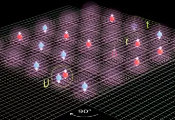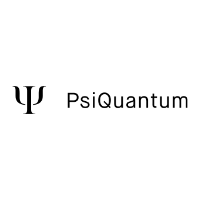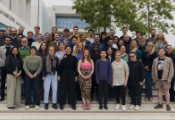Physicists Discover a Correlated Topological Excitonic Insulator With Novel Quantum Properties
October 12, 2025 -- Breakthrough from Princeton team reveals exotic quantum state that coherently blends many-body correlation and quantum topology—two key concepts of modern quantum physics in a single material.
For more than fifty years, physicists have investigated the existence of the excitonic insulator. This rare and unconventional quantum phase occurs when electrons and holes combine to form composite particles called excitons that condense into a collective macroscopic coherent quantum state. Unlike ordinary insulators where electrons are simply trapped in place, this exotic state emerges when electrons and holes spontaneously organize into a correlated quantum fluid. But, until now, researchers had never observed the state in a layered or three-dimensional topological material.
A research team in the lab of physicist M. Zahid Hasan, the Eugene Higgins Professor of Physics at Princeton University, has reported the first unambiguous realization of a topological excitonic insulator in a three-dimensional material leading to a new form of Bose-Einstein quantum condensates. The findings, published recently at Nature Physics, highlight Ta₂Pd₃Te₅, a relatively obscure quantum material that now unexpectedly stands at the forefront of quantum many-body physics research. Quantum materials are systems in which quantum mechanical effects — such as entanglement and topology — manifest at macroscopic scales, giving rise to exotic electronic, magnetic, excitonic and optical properties.
“Our finding was completely unexpected,” said Hasan, “Nobody predicted it in theory before its observation in topological materials”
This discovery merges two of the most fundamental concepts in modern physics—quantum correlations and topology in a novel way. The former describes the collective behavior of interacting particles and is crucial for understanding many-body systems and for developing new quantum technologies. Topology is a branch of mathematics that studies properties preserved under deformation—imagine a coffee cup that can be stretched into a donut shape but retains the same essential “hole” structure in its space of wavefunctions. In physics, this translates to materials whose electronic properties remain robust despite imperfections or changes in the material. In topological materials, electrons can flow along protected surfaces or edge channels even when the bulk material is insulating—creating materials with exotic electronic and quantum entanglement properties.
The challenge has been finding a material where these two phenomena—strong particle correlations and topological protection—naturally coexist and reinforce each other which also minimize structural distortion. Until now, no bulk material had been shown to naturally host these phenomena in a single macroscopic quantum state.
“It’s extremely rare,” said Hasan. “Most candidate systems identified over the last five decades suffer from ambiguity because structural distortions or competing orders mask the signature of an excitonic Bose condensate insulator.”
Specifically, an excitonic insulator is a unique state of matter where a negatively charged electron and its corresponding positively charged hole become bound together by Coulomb attraction, forming neutral quasiparticles of Bosonic character called excitons. This binding is indicated by a gap that forms in the electronic energy spectrum—a many-body effect caused by the spontaneous Bose-Einstein condensation of excitons.
“A suitable atomic chemistry and structure design coupled to first-principles theory was the crucial first step to search for topological materials with novel properties” said Hasan. “There are hundreds of topological materials, and we need both intuition, experience, materials-specific calculations, and intense experimental efforts to eventually find the right material for in-depth exploration. And that took us on a decade-long journey of investigating many candidate materials.”
The team used state-of-the-art scanning tunneling microscopy, spectroscopy, angle-resolved photoemission spectroscopy, transport measurements, and theoretical modeling to show that Ta₂Pd₃Te₅ enters an excitonic insulating state below approximately 100 degrees Kelvin.
“We observed a clear gap opening in the electronic structure that is of many-body nature,” said Shafayat Hossain, the first author of the paper former postdoc in Hasan Lab and currently assistant professor at the University of California, Los Angeles. “What’s more remarkable is that this gap hosts a topological boundary mode—a hallmark of nontrivial topology. Such a thing was not never directly observed before.”
“Our detailed angle-resolved photoemission spectroscopy measurements showed that the gap opening is accompanied by a unique form of band hybridization specific to excitonic Bose condensation,” said Hasan.
But the surprises didn’t stop there. As the temperature dropped below 5 degrees Kelvin, the team found evidence for a second excitonic condensation instability—one that breaks the underlying crystal’s translation symmetry and produces a superlattice modulation in real space.
“This secondary electronic instability occurs at finite momentum, something that’s never been seen before in such a system,” said Zi-Jia Cheng, a graduate student and co-first author.
“We could even tune and control the wavevector of this modulation continuously by applying a magnetic field,” added Hossain.
Hasan stated that this quantum control or external tunability serves as strong evidence for a finite-momentum excitonic Bose-Einstein condensate, which refers to a quantum fluid of bound electron-hole pairs carrying momentum.
The implications are broad and potentially transformative. Excitonic Bose-Einstein condensates, like superconductors, can transport energy without resistance. Their combination with topology could further enable dissipation-less electronics, quantum computing components, or electrically tunable optical devices.
Other researchers, including Sanfeng Wu, assistant professor of physics at Princeton University, have demonstrated excitonic behavior in two-dimensional heterostructures such as monolayer WTe₂ whose bulk material is a Weyl semimetal. However, those systems rely on artificial confinement, and the excitonic transition itself is not topological—they cannot host this phenomenon in three-dimensional crystals.
In contrast, Ta₂Pd₃Te₅ represents a bulk layered material exhibiting excitonic condensation through its own internal physics, without requiring monolayer formation or external engineering. Crucially, the excitonic transition itself creates the topological order, making this an intrinsic topological excitonic insulator. Additionally, the Bose condensates of excitons can be tuned via a magnetic field which is an unprecedented property observed for the first time in quantum materials.
“This is the first time we’re seeing both topology and excitonic correlation dance together in a bulk 3D material and form together via a single-phase transition which is topological,” said Yu-Xiao Jiang, another co-first author of the paper and Princeton graduate student. “Our team demonstrated that a quantum material can display correlation-driven, tunable excitonic instabilities that are linked with symmetry-protected topological orders” he said.
Researchers are already exploring similar compounds in hopes of discovering new materials where correlation and topology coexist, potentially with even more exotic properties. For now, however, Ta₂Pd₃Te₅ stands alone as a kind of quantum Rosetta stone—a singular material helping physicists decode the complex interplay of the quantum world’s deepest forces.
“The novel topological properties of matter have emerged as one of the most sought-after treasures in modern physics, both from a fundamental physics point of view and for finding potential applications in next-generation quantum engineering and nanotechnologies,” said Hasan. “This work was enabled by multiple innovative experimental advances in our lab at Princeton.”
The discovery opens a new chapter in quantum materials research. As Hasan put it: “It’s like finding water in an exoplanet. If one exists, it’s likely there are more out there.”
Background of the experiment
This research’s roots lie in the workings of the quantum Hall effect—a form of topological effect that was the subject of the Nobel Prize in Physics in 1985. Since that time, topological phases have been studied and many new classes of quantum materials with topological electronic structures have been found. Most notably, Daniel Tsui, the Arthur Legrand Doty Professor of Electrical Engineering, Emeritus, at Princeton, won the 1998 Nobel Prize in Physics for discovering the fractional quantum Hall effect. Similarly, F. Duncan Haldane, the Eugene Higgins Professor of Physics at Princeton, won the 2016 Nobel Prize in Physics for theoretical discoveries of topological phase transitions and a type of two-dimensional topological insulator. Subsequent theoretical developments showed that topological insulators can take the form of two copies of Haldane’s model based on electron’s spin-orbit interaction.
Hasan and his research team have been following in the footsteps of these researchers by investigating new aspects of topological quantum materials and searching for novel states of quantum matter. This led them, in 2007, to the discovery of the first examples of three-dimensional topological insulator state. Since then, Hasan and his team have been on a decade-long search for novel quantum properties in topological materials that combine symmetry, topology and correlation especially in magnetic Weyl semimetals that the team discovered about a decade ago. The latest discovery shows that certain classes of topological materials can host quantum many-body states such as the topological excitonic Bose-Einstein condensates that break important symmetries and exhibit spontaneously developed quantum emergence at low temperatures.
The study, “Topological excitonic insulator with tunable momentum order,” by Md Shafayat Hossain, Zi-Jia Cheng, Yu-Xiao Jiang, Tyler A. Cochran, Song-Bo Zhang, Huangyu Wu, Xiaoxiong Liu, Xiquan Zheng, Guangming Cheng, Byunghoon Kim, Qi Zhang, Maksim Litskevich, Junyi Zhang, Jinjin Liu, Jia-Xin Yin, Xian P. Yang, Jonathan D. Denlinger, Massimo Tallarida, Ji Dai, Elio Vescovo, Anil Rajapitamahuni, Nan Yao, Anna Keselman, Yingying Peng, Yingying Peng, Yugui Yao, Zhiwei Wang, Luis Balicas, Titus Neupert & M. Zahid Hasan was published in 2025 in Nature Physics.
The research at Princeton was funded by the Gordon and Betty Moore Foundation (GBMF9461) and the US DOE under the Basic Energy Sciences program (grant number DOE/BES DE-FG-02-05ER46200) and the US Department of Energy, Office of Science, National Quantum Information Science Research Centers, Quantum Science Center (at ORNL) and Princeton University; STM Instrumentation support from the Gordon and Betty Moore Foundation (GBMF9461) and the theory work; and support from the US DOE under the Basic Energy Sciences program (grant number DOE/BES DE-FG-02-05ER46200) for the theory and sample characterization work including ARPES. Additional support for the STM & ARPES technique and instrumentation development came from the US DOE under the Basic Energy Sciences.




































